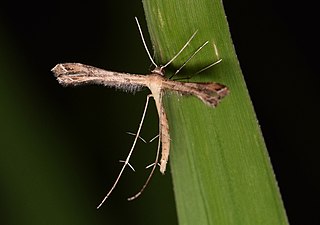
Hipparchus was a Greek astronomer, geographer, and mathematician. He is considered the founder of trigonometry, but is most famous for his incidental discovery of the precession of the equinoxes. Hipparchus was born in Nicaea, Bithynia, and probably died on the island of Rhodes, Greece. He is known to have been a working astronomer between 162 and 127 BC.

The Pterophoridae or plume moths are a family of Lepidoptera with unusually modified wings. Though they belong to the Apoditrysia like the larger moths and the butterflies, unlike these they are tiny and were formerly included among the assemblage called "microlepidoptera".
On Sizes and Distances (of the Sun and Moon) (Περὶ μεγεθῶν καὶ ἀποστημάτων [ἡλίου καὶ σελήνης], Peri megethon kai apostematon) is a text by the ancient Greek astronomer Hipparchus (c. 190 – c. 120 BC) in which approximations are made for the radii of the Sun and the Moon as well as their distances from the Earth. It is not extant, but some of its contents have been preserved in the works of Ptolemy and his commentator Pappus of Alexandria. Several modern historians have attempted to reconstruct the methods of Hipparchus using the available texts.

Stenoptilodes taprobanes is a moth of the family Pterophoridae. This species has a pantropical distribution, which extends into subtropical areas.

Pterophorus albidus is a moth of the family Pterophoridae. It is distributed in Africa, south and south-east Asia, including New Guinea and Australia, as well as Japan (Kyushu) and the Ryukyu Islands.
Leptodeuterocopus is a genus of moths in the family Pterophoridae. It was erected in 1910 by Thomas Bainbrigge Fletcher, and has Leptodeuterocopus citrogaster as type species. Several of its species were originally described in genera Deuterocopus or Oxyptilus.
Leptodeuterocopus exquisitus is a moth of the family Pterophoridae that is known from Brazil.
Leptodeuterocopus fortunatus is a moth of the family Pterophoridae that is known from Brazil.
Leptodeuterocopus trinidad is a moth of the family Pterophoridae that is known from Trinidad and Venezuela.
Leptodeuterocopus tungurahue is a moth of the family Pterophoridae that is known from Ecuador.
Leptodeuterocopus panamaensis is a moth of the family Pterophoridae that is known from Panama.
Leptodeuterocopus angulatus is a moth of the family Pterophoridae that is known from Brazil.
Leptodeuterocopus duchicela is a moth of the family Pterophoridae. It is known from Ecuador.
Leptodeuterocopus neales is a moth of the family Pterophoridae that is known from Costa Rica, Ecuador, Guatemala, Mexico, Suriname, Paraguay, Peru and Venezuela. It has recently been recorded from Florida.
Leptodeuterocopus sochchoroides is a moth of the family Pterophoridae that is known from Brazil.
Leptodeuterocopus zonites is a moth of the family Pterophoridae that is known from British Guyana.
Leptodeuterocopus gratus is a moth of the family Pterophoridae that is known from Peru.
Leptodeuterocopus sorongensis is a moth of the family Pterophoridae that is known from Papua New Guinea.
Leptodeuterocopus citrogaster is a moth of the family Pterophoridae. It was described by Thomas Bainbrigge Fletcher in 1910 and is known from the Moluccas. It is the type species of the genus Leptodeuterocopus.

In combinatorics, the Schröder–Hipparchus numbers form an integer sequence that can be used to count the number of plane trees with a given set of leaves, the number of ways of inserting parentheses into a sequence, and the number of ways of dissecting a convex polygon into smaller polygons by inserting diagonals. These numbers begin
This page is based on this
Wikipedia article Text is available under the
CC BY-SA 4.0 license; additional terms may apply.
Images, videos and audio are available under their respective licenses.




